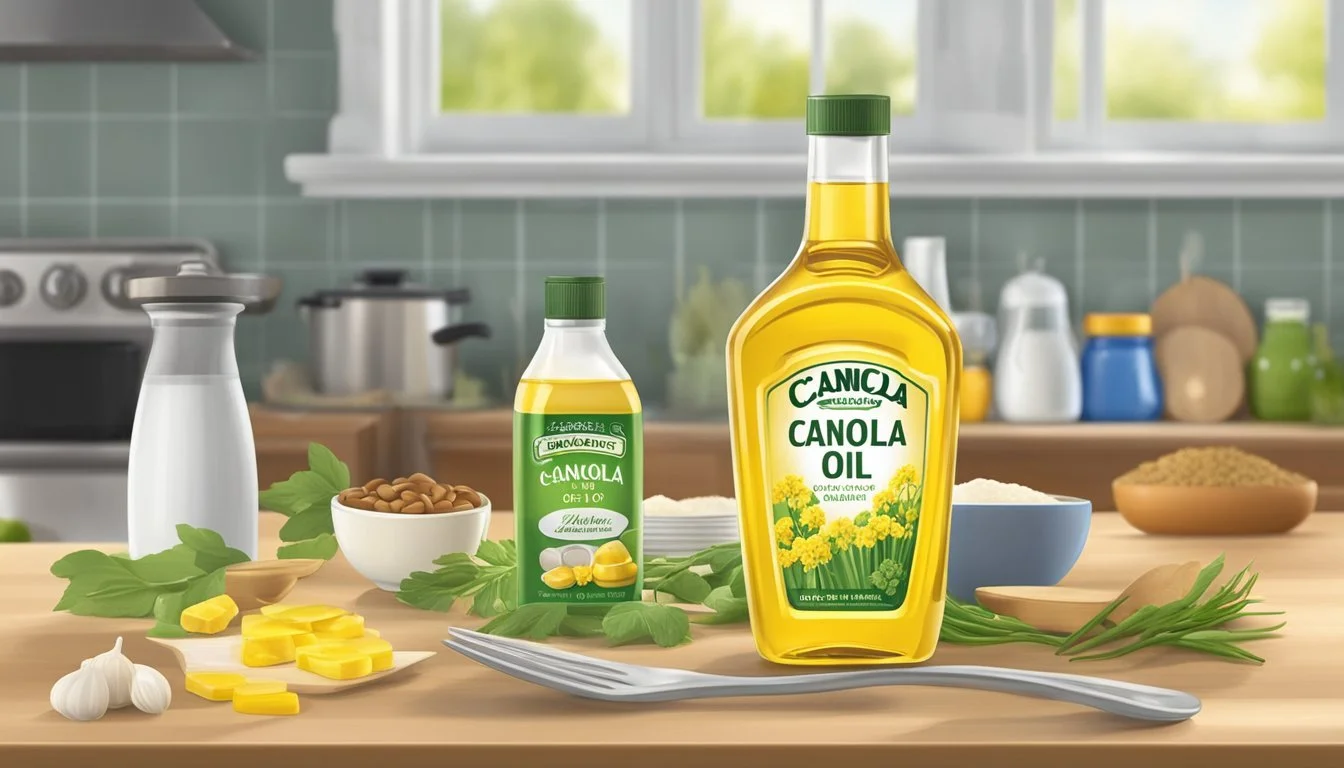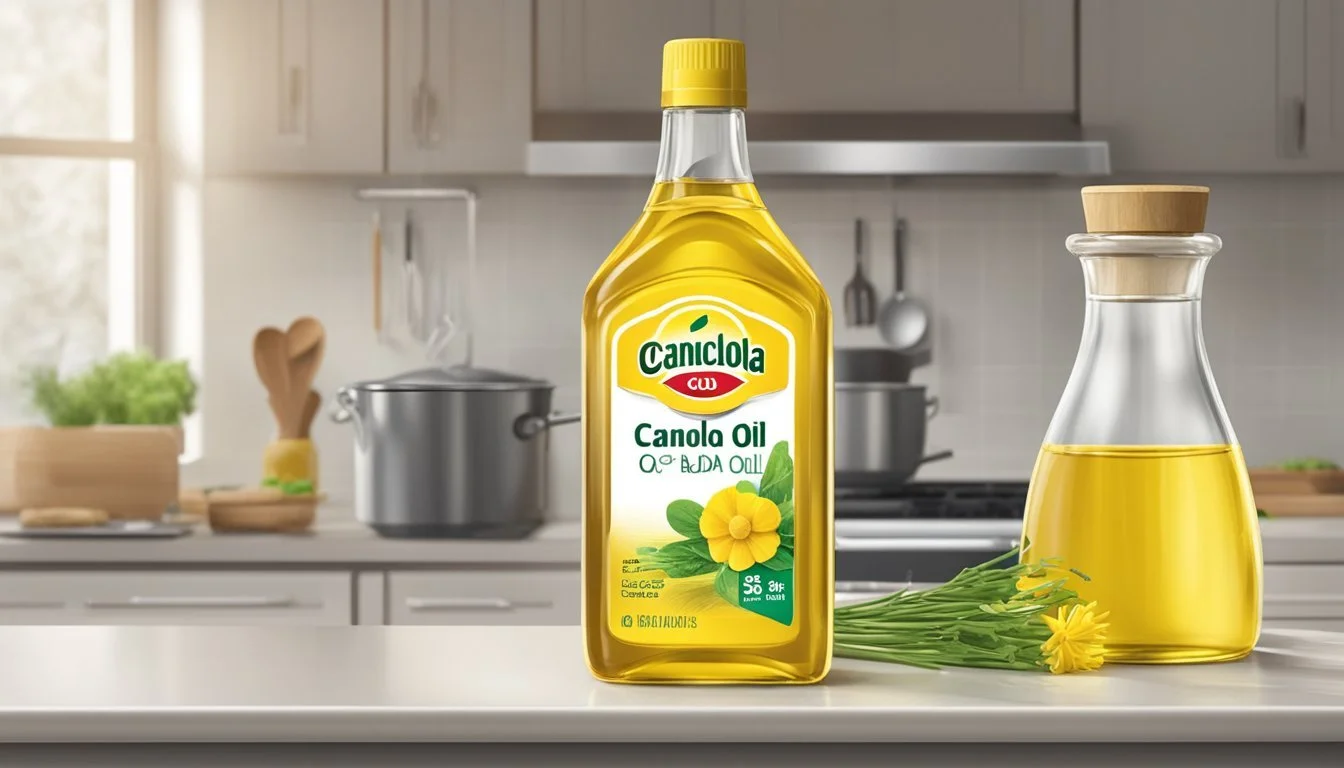Does Canola Oil Go Bad?
Understanding Shelf Life and Spoilage Signs
Canola oil, like all edible oils, has a shelf life and can go bad, which can impact its taste, aroma, and nutritional benefits. The longevity of canola oil depends on whether it is opened or unopened, as well as the conditions under which it is stored. Unopened canola oil generally has a shelf life of 12 to 24 months. However, once opened, its shelf life typically reduces to a span of between 6 to 12 months.
The oil can become rancid when the fatty molecules are exposed to oxygen, light, or heat, affecting the quality and leading to an unpleasant smell and taste. To maximize its shelf life and maintain its quality, canola oil should be stored in a cool, dark place, away from direct sunlight and hot temperatures. If stored improperly, the rate of rancidification can increase, and the oil may spoil before the anticipated expiration date.
Identifying spoiled canola oil involves using senses such as smell and taste. Fresh canola oil has a light, neutral scent and flavor, but when spoiled, it emits a strong, unpleasant odor and has a bitter or sour taste. It is important for consumers to recognize these signs of degradation to ensure the oil used in their cooking is of good quality and to avoid the off-flavors that can affect the dishes they prepare.
Understanding Canola Oil
Canola oil, known for its versatility in the kitchen, is a heart-healthy option compared to many other vegetable oils. This section explores its origins and what sets it apart from alternative oils.
Origin and Composition
Canola oil originates from the seeds of the canola plant, a genetically modified form of the rapeseed plant, which was altered to reduce the erucic acid content and eliminate potentially harmful glucosinolates. It predominantly contains heart-healthy monounsaturated fats and a low level of saturated fat, making it a staple in health-conscious diets.
Monounsaturated fats: approximately 63%
Polyunsaturated fats: around 28% (which includes omega-3 and omega-6 fatty acids)
Saturated fats: about 7%
The reduction of erucic acid, a substance found in traditional rapeseed oil, makes canola oil safer for consumption and has contributed to its widespread adoption.
Comparison with Other Vegetable Oils
When evaluating canola oil against other oils in the vegetable oil category, its profile is notable for its low saturated fat content and beneficial omega fatty acid composition. Understanding this helps consumers make informed choices about their cooking oils, especially when considering heart health.
Canola Oil vs. Other Vegetable Oils:
Saturated Fat Content: Canola oil typically contains less saturated fat than palm, coconut, and soybean oils.
Smoke Point: It has a high smoke point (about 400°F), which is comparable to or slightly higher than many other vegetable oils, making it suitable for a variety of cooking methods, including frying and baking.
Flavor: Canola oil has a mild, almost neutral flavor, contrasting with olive oil that imparts a distinct taste, influencing culinary applications.
Canola oil's composition positions it as a heart-healthy option, leading to its recommendation by health authorities and widespread adoption in both home and professional kitchens.
Signs of Spoilage
When canola oil goes bad, it undergoes noticeable changes. Becoming rancid through oxidation is the most common form of spoilage. The oil's exposure to heat, air, or light prompts this process, resulting in observable signs.
Visible Changes in Appearance
One can detect the spoiling of canola oil by looking for changes in its appearance. If the oil shows any signs of cloudiness, sediment, or mold, these are indications that the oil has gone bad. While cloudiness can occur in colder temperatures and is not always a sign of rancidity, the presence of sediment or mold is a definite marker of spoilage.
Altered Smell and Taste
Rancid oil has a distinctively unpleasant smell and taste. If canola oil emits a sharp, bitter odor akin to old nuts or putty, this is a clear sign it is rancid. In terms of taste, if the oil leaves a greasy or stale aftertaste, it has likely reached the end of its shelf life and should not be consumed.
Shelf Life
Canola oil's shelf life differs significantly based on whether the bottle has been opened or remains sealed. Knowledge of these factors is essential for maintaining the oil's quality and ensuring safety in consumption.
Unopened Canola Oil
An unopened bottle of canola oil typically has a shelf life of 12 to 24 months from its production date. Stored in a cool, dark place away from direct heat or light, it retains its quality well up to the printed best-by date and often remains suitable for use for an additional 6 to 12 months.
Storage facts:
Best-by date: Reliable indicator of peak quality
Time before spoiling: Possibly an extra 6 to 12 months post best-by date if stored properly
Opened Canola Oil
Once the seal is broken, the shelf life of canola oil is reduced to about 6 to 12 months. The key to preserving opened canola oil for the longer end of this range is to keep it in a cool, dark location and ensure the cap is securely fastened after each use to prevent oxidation.
Critical points:
After opening: Best used within 6 to 12 months
Signs of expiration: Deterioration of smell, taste, and color indicate that the oil has likely gone bad
In both cases, it is imperative to observe the oil for any signs of spoilage such as a rancid smell or off taste before using it, regardless of its position relative to the expiration date or best-by date.
Proper Storage Techniques
In maintaining the freshness of canola oil, the selection of storage conditions and methodologies is paramount. Proper techniques help to preserve the quality and extend the usability of the oil.
Ideal Storage Conditions
Canola oil should be stored in a cool and dark place to prevent degradation. A pantry or a cabinet located away from heat sources and sunlight is recommended. It's important for the oil to be kept in a tightly sealed container, ideally in a dark glass bottle, which can further protect it from light.
Location: Pantry or dark cupboard
Temperature: Cool, away from heat sources
Container: Sealed, preferably dark glass
Extending Shelf Life Through Refrigeration
Although not always necessary, refrigerating canola oil can extend its shelf life. Refrigeration is particularly beneficial if the oil will not be used quickly. When refrigerated, canola oil should remain in a tightly sealed container to prevent it from absorbing other odors.
Refrigerate: If not used promptly
Container: Must remain sealed
Note: May thicken, but will return to normal consistency at room temperature
Impact of Heat and Light
When storing canola oil, the two environmental factors that can significantly reduce its shelf life are heat and light. They accelerate the oxidation process, leading to rancidity, which negatively affects the oil's flavor and nutritional value.
How Heat Affects Canola Oil
Heat expedites the oxidation of canola oil, causing it to become rancid. The ideal storage temperature for canola oil is at or below room temperature, away from direct heat sources such as stoves or ovens. Rancidity occurs when the oil’s molecules react with oxygen, and heat serves as a catalyst for this oxidation process.
Room Temperature: Store at or below room temperature (generally below 68°F or 20°C) to slow down oxidation.
Heat Sources: Keep the oil away from heat-producing appliances.
Sunlight and Storage Locations
Sunlight can drastically shorten the lifespan of canola oil due to the UV rays contributing to the oxidation. This is why canola oil should be stored in a cool, dark place.
Avoid Sunlight: Store oil in a dark-colored bottle or in a cabinet to limit light exposure.
Storage Locations: A pantry or a cupboard, away from windows or other sources of natural light, is ideal for storing canola oil.
How to Determine Canola Oil's Usability
Determining the usability of canola oil is crucial for both the taste and safety of your food. One can assess the condition of canola oil through sensory tests and by understanding its expiration dates.
Sensory Tests
Smell: A primary indicator of canola oil's condition is its odor. Fresh canola oil should have a neutral, almost imperceptible smell. If the oil emits a strong, off-putting smell, it has likely gone rancid.
Taste: Should oil pass the smell test, a small taste test is advised. Fresh canola oil tastes clean and should have almost no flavor. A bitter or sour taste indicates spoilage.
Visual Clues: The appearance can also signal if canola oil has gone bad. Fresh oil has a light yellow hue. Any drastic change in color suggests deterioration.
Understanding Expiration Dates
Label Information: Canola oil packages feature a "best by" or expiration date, which provides a good baseline for its shelf life.
Shelf Life Post-Opening: Once opened, canola oil's optimal usage period is 6 to 12 months, assuming proper storage conditions—a cool, dark, and dry space.
Optimal Conditions: Unopened, canola oil can last up to two years when stored correctly. However, if it has passed the printed expiration date, sensory tests are recommended to determine usability.
Health and Consumption
When considering the health implications and consumption aspects of canola oil, it is vital to understand the effects of rancidity and its nutritional profile.
Risks of Consuming Rancid Oil
Consuming rancid canola oil can pose health risks, as it may lead to digestive discomfort such as nausea and diarrhea. The oxidation of oil results in the formation of harmful free radicals and other compounds that can be detrimental to health when ingested. It's also important to note that the unpleasant flavor of rancid oil can spoil the neutral and desired taste of canola oil that is often appreciated for its versatility in cooking.
Nutritional Considerations
Canola oil is recognized for its nutritional value, especially when it is fresh and properly stored. It is a source of unsaturated fats, including monounsaturated fat (omega-9) and polyunsaturated fat (omega-3 and omega-6), which are considered beneficial for heart health.
Here is a brief nutritional overview of canola oil:
Calories: 124 kcal per tablespoon
Total Fat: 14 grams
Saturated Fat: 1 gram
Monounsaturated Fat: 9 grams
Polyunsaturated Fat: 4 grams
Vitamin E: 16% of the Daily Value (DV)
Vitamin K: 8% of the DV
Consumers should be aware that while canola oil provides certain health benefits, balance and moderation are key in a healthy diet.
FAQs about Canola Oil
When it comes to preserving the quality of canola oil, understanding the best storage methods is essential. Proper storage can significantly extend the oil's shelf life, whether it is kept in a pantry, refrigerator, or even a freezer.
Storing in Pantry vs. Refrigerator
Pantry Storage:
Duration: Unopened canola oil typically lasts up to 2 years when stored in a pantry. Once opened, it should be used within 6 to 12 months to ensure quality.
Conditions: Store canola oil in a cool, dark, and dry place away from heat sources and light to prevent oxidation, which leads to rancidity.
Refrigerator Storage:
Potential Benefits: Refrigerating canola oil can extend its freshness by reducing the rate of oxidation.
Considerations: Canola oil may become cloudy when refrigerated, but this does not affect its quality or safety.
Freezing Canola Oil
Freezing: Canola oil can be frozen, although it is not typically necessary for extending shelf life.
Effects: Freezing canola oil will not significantly alter its taste or nutritional value once thawed.
Method: If one chooses to freeze canola oil, it should be in a sealed, airtight container to prevent moisture and odors from affecting it.
Comparing Canola Oil with Other Cooking Oils
When considering canola oil in comparison to other cooking oils, the discussion often centers on two main attributes: the smoke point and the flavor profile. These characteristics greatly influence an oil's suitability for different cooking applications.
Smoke Points and Cooking Uses
Canola oil is known for its high smoke point of approximately 468 degrees Fahrenheit, making it an excellent option for deep frying and a variety of high-heat cooking methods. In contrast, oils like extra virgin olive oil have lower smoke points, which makes them less ideal for high-temperature cooking, but suitable for dressings and low-heat applications.
Other oils with high smoke points include:
Avocado oil: 520 degrees Fahrenheit – ideal for searing and grilling
Grapeseed oil: 420 degrees Fahrenheit – suitable for frying and sautéing
Sesame oil: 350 to 410 degrees Fahrenheit (toasted sesame oil has a lower smoke point) – best used for stir-frying and flavoring
Flavor Profiles and Alternatives
The neutral flavor of canola oil is beneficial when a cook does not want to overshadow the flavors of other ingredients. On the other hand, oils such as sesame oil impart a distinct taste, often associated with Asian cuisine.
Oils and their flavors:
Canola oil: Mild, neutral
Sesame oil: Nutty, aromatic (particularly toasted varieties)
Grapeseed oil: Light, clean
Avocado oil: Slightly grassy, buttery
When substituting oils, one must consider the intended flavor result as well as the cooking method to ensure the choice enhances the dish.









